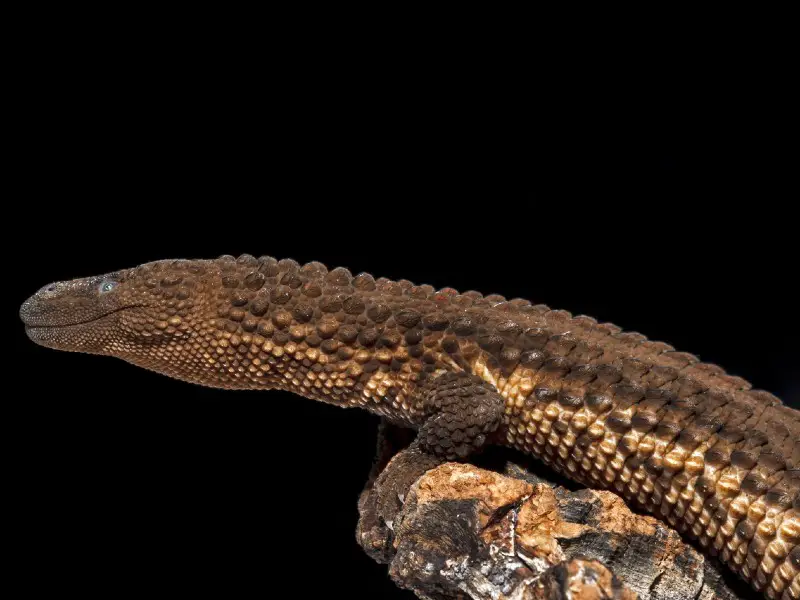
The Earless Monitor Lizard is a semi-aquatic reptile (able to live in both land and water), although their favorite place is living near rocky streams and marshes.
Earless Monitor Lizards are commonly found in rainforests and wetlands, but they are also found in streams flowing through poor agricultural habitats such as matured fruit tree gardens, palm oil plantations, and sometimes in rice fields.
The Earless Monitor Lizard is originally from the island of Borneo and Brunei (Southeast Asia), as well as Sarawak (East Malaysia), West and North Kalimantan (Indonesia).
The Earless Monitor Lizard, scientifically known as Lanthanotus Borneensis belongs to the Lanthanotidae family which means “hidden ear” (Lanthanotus). The Earless Monitor is the only living species in the family Lanthanotidae.
Earless Monitor Lizards are dark reddish-brown, with a scaly appearance and cylindrical body shape. The body of the Earless Monitor Lizard is not too long, however, their bodies are larger compared to other lizards.
Although some Monitor Lizard species, like the Timor Tree Monitor, are smaller, many other species grow a few feet long on average.
The Earless Monitor Lizards have long necks, short limbs, long sharp claws, and small, round, blue, beaded-like eyes. semi-transparent lower eyelids, and six long rows of strongly keeled scales across their body.
Earless Monitor Lizards have no visible ear openings or externally visible signs of ears (hence the name). They have no presence of a tympanum, a common characteristic of an ear protuberance in reptiles. However, the Earless Monitor Lizard can indeed hear.
The gender difference between the Earless Monitor Lizard male and female is visible from around three years of age. Earless Monitor males have a characteristic broader head and tail base than females.
The Earless Monitor Lizard has a forked tongue and a fully prehensile tail. Although if the tail is hurt or damaged, it cannot be fixed or grow again.
Care Guide
The Earless Monitor Lizard was initially considered a rare species, but its breeding has increased in recent years.
Earless Monitor Lizards are from tropical weather and are often found in wetlands.
In a survey carried out with locals in Malaysia, 90% have confirmed being aware of the presence of the Earless Monitor Lizard and consider them very common; however, some other locals in the washing and fishing areas reported to be unaware of their presence.
The Earless Monitor Lizard isn’t extinct yet, but it has been classified as vulnerable or endangered by the IUCN (International Union for Conservation of Nature).
Removing an Earless Monitor lizard from the wild is illegal, and some steps have been taken to control the wildlife and pet trading, including zoos.
Although the price to trade Earless Monitor Lizards has fallen by more than 90% due to increased availability, it remains valuable.
The Earless Monitor Lizard species make good pets, and the care steps apply to them as any other Monitor Lizard.
All Monitor Lizard species need light and a heat source. It is important to follow the instructions of the carer or breeder you get your Earless Monitor Lizard from. It is also important to take care and never release a pet Earless Monitor lizard into the wild.
Provide food and water bowls and clean the bowls daily with soapy water.
Empty and clean paddling pools daily or every other day depending on if the paddling pool water has been contaminated with the Earless Monitor Lizard waste.
Remember to clean branches, ramps, and any other decorations. The dirty substrate should be removed daily.
Feeding
The individual diet depends on your Earless Monitor Lizard. Most Monitor Lizards are carnivores; they eat meat only.
A few of the Monitor Lizard species are omnivorous; they eat both meat and plants. Many of the Monitor Lizard omnivorous species eat fruit as the first choice in their diets.
The Earless Monitor Lizard is a carnivore Monitor Lizard, and its delicacies are insects like crickets, mealworms, cockroaches, grasshoppers, as well as fish.
A captive Earless Monitor Lizard would feed on fish, earthworms, squid, mussels crustaceous like shrimps, tadpoles, green sea turtle eggs (they refused to try the bird eggs), pieces of pig and chicken liver, and baby mice.
Commonly, an Earless Monitor Lizard adult feeds once or twice per week, but sometimes they have longer periods where they do not eat. The Earless Monitor Lizard can swallow prey while underwater.
The length from the snout (nose, mouth, and jaw) to the vent in the Earless Monitor adult lizard is around 20 cm.
Feed the Earless Monitor Lizard with mice of the appropriate size. Provide your pet with pre-killed mice. Raw foods are available at a grocery store, and all provisions should be chopped or ground into bite-size pieces.
There is commercial food for captive Earless Monitor Lizards designed to supply the right number of vitamins and nutrients. Adjust the Earless Monitor diet with calcium and vitamin D3 supplements and a reptile multivitamin.
Provide an Earless Monitor Lizard with heavy bowls or those that can be hung to the side of the cage to avoid spilling. Bowls with water should be always provided even though you are providing a paddling pool too.
An interesting fact about the larger Monitor Lizard is that they hunt larger prey.
Monitor Lizards eat everything from the smallest insects to the largest deer or even buffalo. Monitor Lizards mainly feed on birds, eggs, worms, spiders, insects, crabs, small mammals, and large mammals.
Lifespan & Health Concerns
The Earless Monitor Lizards’ mating season is in February, when they are in their natural, tropical, wild habitat. Earless Monitor Lizard male adults are highly territorial, and when kept in groups, you can observe that at least one of the males causes trouble. Earless Monitors mate underwater.
Earless Monitor Lizards are oviparous; they lay their eggs on land, and after three months, the eggs are hatched, providing a good temperature for the incubation period.
After hatching, the young Earless Monitor Lizards are completely independent, showing their hunting skills on their own.
There is no certainty of the actual lifespan of the Earless Monitor Lizard. However, some results collected from captivated Earless Monitor Lizards showed a lifespan of 7.5 years, and some of them passed a decade of existence.
Most common commercial terrariums will not accommodate a large Monitor as they can grow long for up to six feet. According to your requirements, you can build a DIY habitat for the Earless Monitor Lizard using some wire mesh and plywood.
A three-side box plywood wall and a front wire mesh door is perfect. A habitat built with solid walls keeps the temperature at optimal conditions, keeping your tropical Earless Monitor Lizard warm when the climate cools down.
Another option to offer your Earless Monitor Lizard a home is a small room or a large closet. Replace one door with a screened one to ensure lots of ventilation.
Measuring the temperature is as important as airflow when establishing the habitat for your Earless Monitor Lizard. Avoid extreme heat or cold. The habitat should be away from heaters, radiators, air conditioners, windows, or draught areas, to guarantee a long and happy life to your Earless Monitor pet.
Although all the steps have been taken to provide due care to your Earless Monitor pet, such as food, bed, and proper habitat, there are situations where cases of illness or injury arise.
Seeking professional advice is best recommended. Bring with you all the relevant information about your Earless Monitor Lizard that the veterinarian may need. Here are the most common cases raised when caring for an Earless Monitor Lizard:
The Earless Monitor Lizard pet can be a victim of burns if it gets too close to a light or heat source.
Treat minor burns on Earless Monitor Lizard with cool soapy water and apply an antiseptic cream. To prevent the risk of burning, place all lights or heat sources out of reach of the Earless Monitor pet.
Sometimes, the Earless Monitor Lizard suffers from metabolic bone disease caused by a diet that lacks calcium or vitamin D3 or excess phosphorus.
The Earless Monitor Lizard might experience lethargy, weight loss, have swollen limbs or jaw, softening of bones, or constipation. All these symptoms are a result of a poor diet. Adjust the Earless Monitor Lizard diet with the minerals and vitamins necessary for a healthy pet.
The lack of minerals and vitamins is as adverse as having an excess of them. However, Earless Monitor Lizard pets require good levels of calcium and vitamin D3 to be healthy.
Excessive supply leads the Earless Monitor Lizard to hypercalcemia, too much calcium in the blood, which causes weak bones, form kidney stones, and affect the functionality of the heart and the brain. This can be fatal for your Earless Monitor Lizard pet.
Avoid overdoses of vitamins and calcium. Just a small dose a couple of times a week is usually enough for an adult Monitor.
Another problem that the Earless Monitor Lizard faces, associated with poor diet and temperature, is constipation. Earless Monitor Lizards will not open bowels at regular intervals if the temperature of their habitat is not constant and warm. The earless Monitor Lizard kept in the cold will not pass waste causing suppression of appetite.
Pay attention to what is reachable for your Earless Monitor Lizard. Impaction can also be a cause of constipation. Lack of water in your Earless Monitor Lizards’ digestive system causes constipation too.
Make sure your Earless Monitor Lizard pet is always hydrated, keeping the water bowls readily and cleaned. The Earless Monitor Lizards are hardy reptiles that in exceptional circumstances, are susceptible to infections.
Avoid your Earless Monitor Lizard from getting stressed by living in an unsanitary habitat, as this increases the Monitor chances to get illnesses.
Know your Earless Monitor Lizard pet, check for visible symptoms of infection such as swelling, discoloration, abscesses, and loss of appetite. Keeping the Earless Monitor Lizard’s habitat cleaned will enhance their health.
The Earless Monitor Lizard can suffer injuries such as cuts or scratches. Treat the injury with cool soapy water and some antiseptic cream. Seek professional advice if the injury doesn’t heal or gets infected.
If your Earless Monitor Lizard suffers an accident, for example, improper handling, resulting in broken bones or other serious injuries, seeking professional help is highly recommended.
Some Earless Monitor Lizards can show respiratory infection symptoms when they are frequently sneezing when they seem lethargic, and have rapid, shallow breathing.
As aforementioned, a respiratory infection can be caused by the habitat of your Earless Monitor Lizard being constantly cold and damp. However, not only the habitat where your Earless Monitor lives are the only causes of respiratory infections.
Respiratory infections on your Earless Monitor Lizard can be caused by parasites like roundworms (commonly present in wild-caught Earless Monitors), and other parasites that weaken an Earless Monitors’ immune system breaking susceptibility to illness. Professional help and a clean habitat for your Earless Monitor Lizard reduces parasite infestation.
Keeping the Earless Monitor Lizard’s habitat clean, at a proper, constant, and warm temperature preserves the health of your pet.
Earless Monitors will naturally shed skin while growing. It is common to find some patches where they shed, falling off on their own, but sometimes some skin will remain attached to their toes or tail.
Help the shedding process of your Earless Monitor Lizard by giving it a bit of mist with water or providing it with a warm bath.
Another issue that your Earless Monitor Lizard can face is the break or injuring its tail. A small injury or a broken tail can heal rapidly, but a more serious accident or an infection may result in the removal of the tail. The tail on an Earless Monitor is not a mechanism of self-defense, so it won’t grow again if it breaks off.
Earless Monitor Lizards grow long nails in their claws that can break together with their toes from normal activity. Trim your Earless Monitors’ sharp claws to prevent injuries. The Earless Monitor’s nails can be trimmed with a regular nail clipper.
Behavior
Earless Monitor Lizards are nocturnal animals, although rarely some activity can be observed in the daytime.
The Earless Monitor Lizard usually spends the day near water in burrows or under logs, rocks, or some plantations. The Monitor Lizards are generally inactive and slow but can make surprisingly fast movements when startled.
The Earless Monitor Lizard sometimes swings its throat (like frogs do) and flicks itsr forked tongue out, similar to snakes, and communicates by making gentle squeaky vocalizations.
The low-frequency sounds coming from the ground are more important than the sounds borne in the air for the Earless Monitor Lizard.
Earless Monitor Lizards are solitary creatures, rarely getting together in groups.
Earless Monitor Lizards are aggressively territorial and prefer large places where food supply is guaranteed and the high chances of possible mating.
Monitor Lizards swing their time between relaxing in the sun and searching for prey. Some species are nocturnal (active at night), but others are diurnal (active during the day).
The Earless Monitor Lizard makes a good pet; it moves nicely in the water, keeping its semi-transparent eyelids closed while swimming. Earless Monitor Lizards are great swimmers too as they can hold their breath underwater for a long time.
The Earless Monitor seems to prefer some people more than others. Earless Monitor Lizards also like to be stroked.
The Earless Monitor Lizard is a species part of the Monitor group. There are different species of Monitor Lizards, each of them with specific characteristics that are worth mentioning.
Nile Monitor
The Nile Monitor is much larger than the Earless Monitor. The Nile Monitor and the Nile Crocodile are bold species with aggressive attitudes to each other, robbing nests, eating eggs, and stealing hatchlings.
Perentie
This is the largest lizard species in Australia and reaches a full size of up to eight feet long.
Komodo Dragon
The Komodo Dragon is the largest of the dragon species and grows beyond ten feet in length.
Asian Water Monitor
These Monitor lizards easily exceed seven feet in length. Male Monitor lizards reproduce when they are about over one foot long, and females when they are just over one and a half foot long.
How to Keep the Earless Monitor Lizard Safe
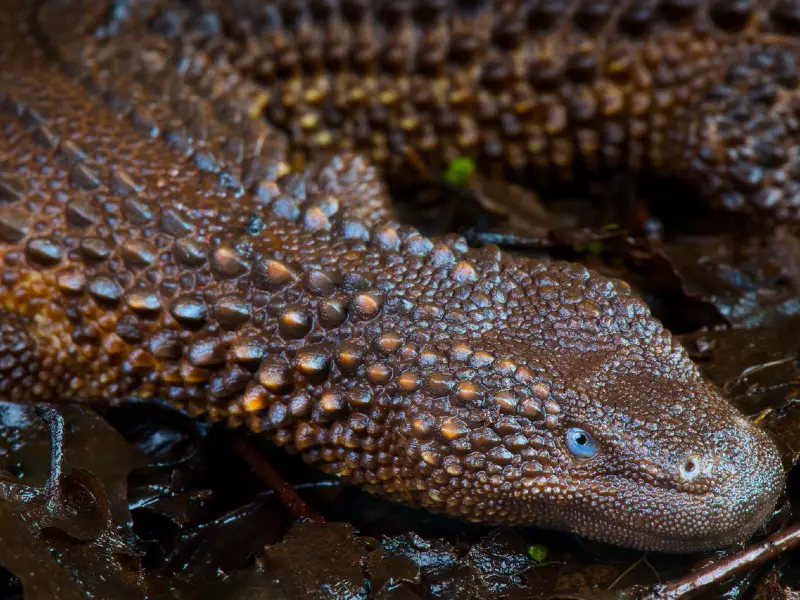
Once you have decided on an Earless Monitor Lizard as a pet, you will do all the preparations necessary to offer your Earless Monitor a home.
The Earless Monitor lizard needs provisions for a balanced and nutritious diet.
The Earless Monitor Lizard also requires a suitable home. Make sure they live in a habitat that is safe and comfortable according to its size.
Purchase a large and tall cage where the size is determined by how big your Monitor Lizard grows as an adult. Always go with the biggest cage possible.
Adding sturdy branches, ledges, shelves, ramps, and other decors to allow your Earless Monitor Lizard to climb, explore and relax. Include an area where your Earless Monitor Lizard can hide and feel safe and secure.
Monitor Lizards that like to be in water will require a warm, paddling pool with some ramps for easy entry and exit. Long UVB fluorescent bulbs that can cover large areas.
Add light fixtures that provide lights and a warm home and help prevent your Earless Monitor Lizard from getting too close to the light and heat sources, which can cause burns.
Keep a thermometer to monitor the temperature of the habitat.
Include a substrate on the bottom of the cage. A mixture of clean dirt and sand is a suitable substrate.
Other options act as suitable substrate normally available in pet shops. It is a natural-looking substrate but easier to clean and to get rid of the Earless Monitor’s waste.
Remember, a clean habitat prevents your Earless Monitor from suffering illnesses and infections.
Does the Earless Monitor Lizard Pose a Threat to Humans?
Earless Monitor Lizards can recognize their owners, and some favor some of the human adults. Earless Monitor Lizards do not tend to attack humans unless they are disturbed when they may bite.
However, Earless Monitor Lizard’s bites are not fatal and heal quickly after being cared for properly, except for Komodo dragons that can injure or even kill humans if provoked. Earless Monitor Lizards are harmless creatures to humans, that’s why they are a favorite to keep as pets.
Some Monitor Lizards are very sociable and live in areas with large human populations, but others don’t like contact with humans.
The biggest threat to Earless Monitor Lizards is the destruction of their habitats, for example, the ample building of oil plants in Malaysia, which are endangering the species.
Earless Monitor Lizards are wild animals, and you will need to provide them with special care, diet, and medical needs.
Average Cost and Where to Buy Earless Monitor Lizard
The Earless Monitor Lizard is a truly mysterious, subterranean, and exotic species chased by collectors for its unique features such as beaded-blue eyes and a lack of visible ears. Traders have recently seen a drop in their retail price due to the increase in supply; however, its price is still valuable.
Facts and Useful Information
|
Species Facts |
|
|
Common Name |
Earless Monitor Lizard, Borneo Earless Monitor |
|
Species Name |
Lanthanotus Borneensis |
|
Family Name |
Lanthanotidae |
|
Price |
Very high price |
|
Size |
15 to 22 cm (6 to 9 inches approx.) |
|
Lifespan |
7.5 years |
|
Diet |
Carnivore. earthworms, crustaceans, and fish. |
|
Tank Size |
According to Monitor size, 8′ x 3′ x 6′. |
|
Humidity and Temperature |
Tropical between 22–29C (72-84F approx.) |
|
Popular Alternatives |
Ackie, Savannah, Asian Water, Pygmy Mulga, and Timor Monitor |
Summary
The Earless Monitor Lizard is a great reptile as a pet; friendly and safe for humans, not to mention how beautiful they are. Earless Monitors are exotic creatures that are easy to look after, providing the needs of shelter, warmth, water, light, and food are met. Adopt an Earless Monitor lizard as a pet legally and make sure to care for it.
References:

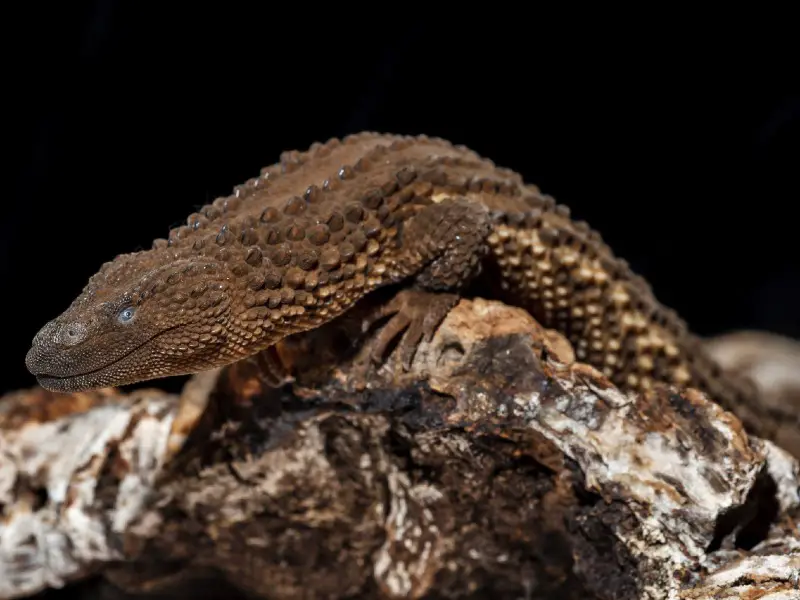

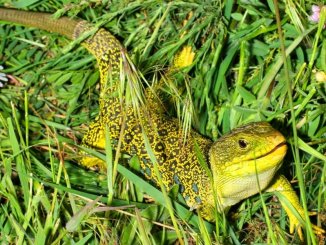
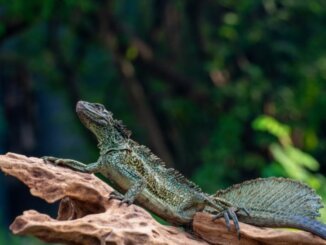

Thank you for the details. I have a lot of changes to make in my pet’s life.